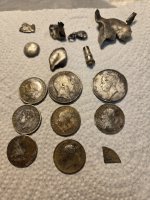itmaiden
Hero Member
- Sep 28, 2005
- 575
- 7
Hi. I have found nothing under the spelling you gave (maybe a different language translation?), however, I did find historical information under "surruque". The State of Florida believes this site to be a prominent Indian Shell Midden in the Cape Canaveral Area, which is known as "Turtle Mound". If you are looking for treasure from this area, I will tell you from other documentation that Florida scored a huge accumulation of gold and silver. If you would like to "see" the treasure, you will have to break into the Tallahassee Vault or wherever else it ended up at. Is Cape Canaveral off limits just for security purposes ? I know more but this is all I will say for the moment. The state beat you to the treasure matey.
Sorry.
itmaiden
Sorry.
itmaiden
Sorroque said:Yes I am certain about the spelling.itmaiden said:Are you sure about your spelling for Sorroquez ? I have found a couple of map references for something similar, one near the Cape and one in the Carolinas if I remember correctly ?
If you can get me something that is definitely accurate or more details, I may be able to help you locate this ?
itmaiden
I have invited to this discusion, (not here@Tnet), a proffesional archeologist that did the Windover digs to my questions about: Sorrope,Surruque,Sorroque, villages. Tekoite, tribe, and the Tiacuma whom were all the same sect of family of the Hitchiti which are now vulgarly renamed by the government that polished them off, Mickasoukee, different than the original Miccosoukee.
Also Sorroquez, and the pirates named, "Sir Rogue", and "Sir Rock".
The archaeologist with the mess,!, of degrees shall be out on assignment and should be back the 16th.
Here is her: Dr. Rachel Wentz
Regional Director
Florida Public Archaeology Network
East Central Region
435 Brevard Ave.
Cocoa, FL 32922
321-690-1971




 Another thing,
Another thing,  ;" The wreck of The Ezmond Fitzgerald" A 70's song about it sunk in a Michagan in a Lake ,... Gitchagoomee. .
;" The wreck of The Ezmond Fitzgerald" A 70's song about it sunk in a Michagan in a Lake ,... Gitchagoomee. .
 )
)

